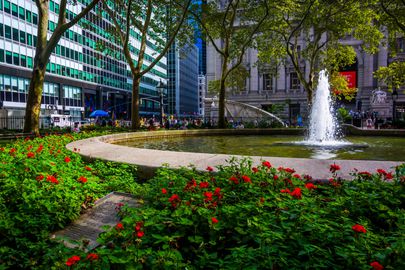

What seems to be an insignificant little grassy area dividing the southernmost tip of Broadway in two is actually the oldest public park in New York City. It is still surrounded by the original 18th century iron fence.
But before the site became a public park in 18th century it had served as a cattle market, a meeting place and a parade ground. And even before the Dutch settled the zone in the beginning of the 17th century the Indians had used it as a council ground. In fact, it was here, on this very spot, that in 1626 the Indians officially sold the island of Manhattan to the Dutch colonists for 60 guilders, which would be approximately $1,050 nowadays. The Indian term "Manhattan" means the island of many hills.
When the public park was created it included a bowling green, that is, a special turf used for the sport of lawn bowls, in which players roll balls so that they stop as close as possible to a smaller ball called a jack.
In 1770, while New York was still a British possession, the government in London commissioned a gilded lead equestrian statue of King George 3d. The 4,000-pound monument was placed in the center of Bowling Green. However, it remained there for only six years: after the Declaration of Independence was read out loud from City Hall, a group of Americans charged at the statue, knocked it over and eventually demolished it.
Another relic that had to be demolished after the founding of the new country was Fort Amsterdam, which stood facing the park. This was the fortification that the Dutch had built when they bought Manhattan from the Indians. In its place the city administration constructed the Government House, which was intended to be the mansion of the country's president. However, George Washington never even set foot inside the house because by the time it was erected, the capital of the United States had been moved to Philadelphia. The mansion was taken down 25 years later. In beginning of the 19th century Bowling Green was surrounded by a series of fashionable townhouses, which were also demolished towards the end of the century, making room for the high-rise office buildings that we see today.